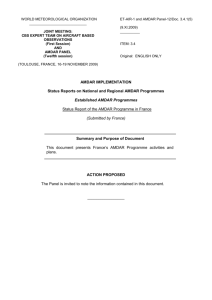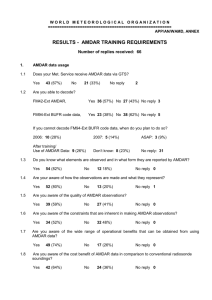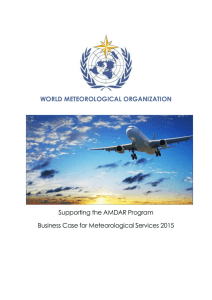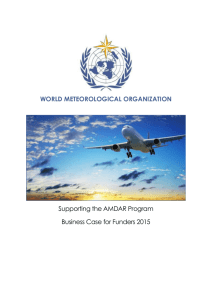Business case template for airline participation
advertisement
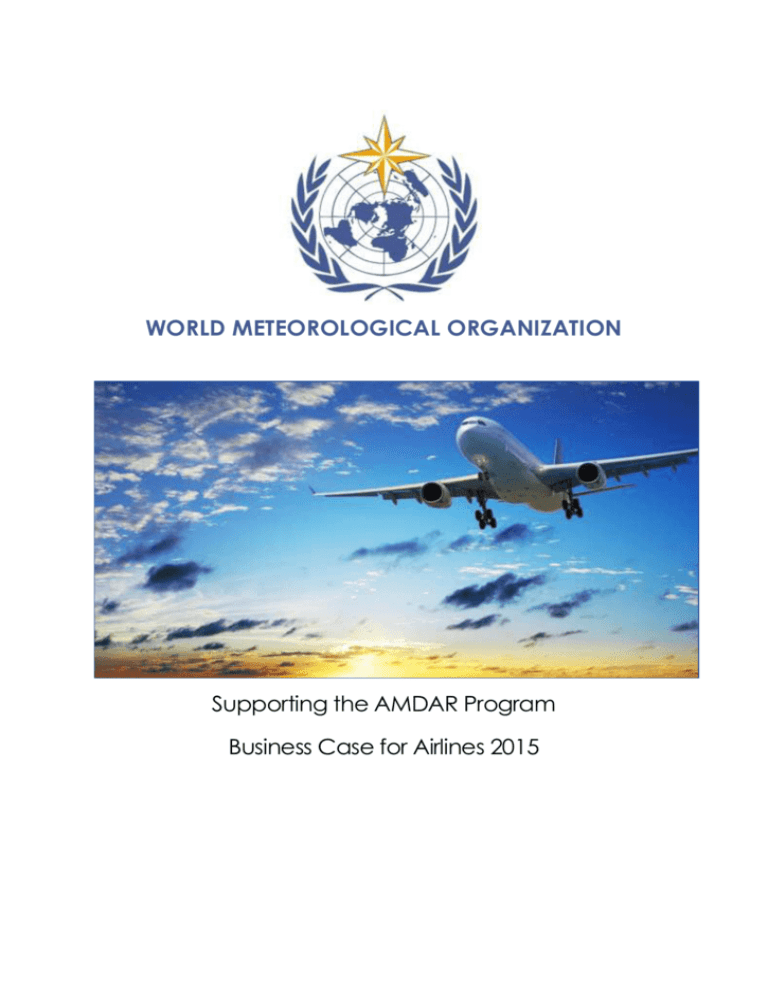
WORLD METEOROLOGICAL ORGANIZATION Supporting the AMDAR Program Business Case for Airlines 2015 EXECUTIVE SUMMARY This document presents and describes the case for supporting the AMDAR program of the World Meteorological Organization, a specialized agency of the United Nations dedicated to weather, water and climate. The AMDAR (Aircraft Meteorological DAta Relay) program brings together airline companies and others from the private sector in partnership with a range of government entities, alongside the WMO. The program delivers a range of economic benefits to airline companies and the aviation industry in general: More efficient flight operations Reduced carbon footprint Increased safety and passenger comfort Data transmission fee revenues Aircraft sensor maintenance support It also brings social and environmental benefits to stakeholders in terms of environmental protection, agriculture, health, and disaster risk reduction. These benefits can help boost airline companies’ marketing and Corporate Social Responsibility (CSR) programs. This document is intended for use by airline companies that may be interested in participating in the program. 2 I. AMDAR OVERVIEW BACKGROUND The Aircraft Meteorological DAta Relay (AMDAR), a program overseen by the World Meteorological Organization (WMO), fosters partnerships between airline companies, weather monitoring and forecasting organizations and other relevant stakeholders. The program uses commercial aircraft’s existing sensors, avionics, and global telecommunications systems to gather, analyze and disseminate data that improves the frequency of weather reporting and the accuracy of weather forecasting.1 The AMDAR system uses sensors on commercial aircraft, such as Korean Air or South African Airways passenger planes, to collect and distribute key meteorological data (wind speed and direction, temperature, etc.) during flight, for improved weather reporting and forecasting worldwide. Automated weather observations by aircraft were first used in 1978, with the first operational AMDAR program beginning in 1986 with just 5 aircraft. Growth has been rapid, as seen in Figure 1 below. To date, the program has grown to include 39 participating airlines and over 3800 commercial aircraft worldwide. Participating airlines include American Airlines, Air Vanuatu, Korean Air, Lufthansa, Shandong Airlines, British Airways, KLM, Cathay Pacific, South African Airways, and Qantas Airways.2 Figure 1 – Global aircraft observations – average of daily report totals3 The growing number of airline partners and AMDAR-equipped aircraft within existing airline fleets are a testament to the value of the program for airlines and the airline industry overall. While stakeholders from a range of sectors share in the benefits of the improved weather forecasting which AMDAR data allows, AMDAR program participants – particularly airline partners – enjoy specific potential benefits in the form of both direct and indirect financial returns, which will be explored in further sections of this report. 1 WIGOS – The Benefits of AMDAR data to Meteorology and Aviation Report 2014 (“WIGOS Benefits Report”) 2 AMDAR program website: http://www.wmo.int/pages/prog/www/GOS/ABO/AMDAR//AMDAR_Airlines.html 3 http://www.wmo.int/pages/prog/www/GOS/ABO/data/statistics/aircraft_obs_cmc_mthly_ave_daily_reports_by_type.jpg 3 AMDAR PROGRAM OPERATION AMDAR utilizes aircraft’s onboard instruments and avionics systems to provide accurate meteorological measurements, such as air temperature and winds. This data is transmitted to the ground, usually by VHF radio or satellite, and from ground stations to meteorological processing centers via the airline’s data processing center. 4 Information on the following parameters is collected at all phases of flight5 as standard: – Altitude (pressure derived) – Temperature – Wind speed – Wind direction Additional parameters which can be optionally collected by participating airlines include: – Humidity – Turbulence These additional parameters require further software application functionality (and in the case of humidity, sensor hardware) – but can improve weather forecasting even further. AMDAR measurements are compiled into a standard message format and transmitted to the partner national weather center, or National Meteorological and Hydrological Services (NMHS), in as near to real-time as possible. Figure 2 – Schematic of the basic AMDAR system* * Reflects major service providers contracted by participating airlines. National service providers, such as Brazil and China, also participate in the program. More detailed information on the AMDAR observing system is available from the WMO AMDAR website (http://www.wmo.int/pages/prog/www/GOS/ABO/AMDAR/About.html). 4 Data transmitted from aircraft using ACARS (Aircraft Communications Addressing and Reporting System). AMDAR Coverage and Recruitment Study 2013 5 EUMETNET AMDAR presentation at Royal Meteorological Society 2013 4 II. BENEFITS OF AMDAR AND IMPROVED FORECASTING Why AMDAR? The accuracy, high reporting volume and frequency and timeliness of AMDAR data makes AMDAR an important factor in improved weather monitoring and prediction, which has a wide range of benefits for the aviation industry. AMDAR data has been proven effective in improving the quality and accuracy of weather reports – reducing forecast errors by up to 20%. It is recognized by the WMO as a critical component of the WMO Integrated Global Observing System (WIGOS), supporting the World Weather Watch (WWW) Programme. Indeed, AMDAR data is assessed as the second 6,7 or third8 most important data set globally for improving 24 hour forecasts, depending on the study – and the data source with the most consistent impact. Aviation and public weather forecasters make use of AMDAR data for both the verification and updating of forecasts in the shorter-term, and in the periods between updates of forecasts based on predictive models (usually made every 6 or 12 hours). This advantage and resulting enhancement to forecast skill is derived from the high temporal availability of AMDAR data (often as frequent as one or more vertical profiles per hour). 9 The data continues to have a positive impact on forecasts up to 48 hours out. Compared with other weather monitoring and reporting systems, AMDAR is also a highly cost effective solution, in most cases requiring only the deployment of an avionics software application. Indeed, a recent Met Office study on the benefit of different observing systems10 found AMDAR to give the highest impact per cost.11 AMDAR has other benefits: it is unique as the only source of in situ upper air data taken throughout the day (rather than at set times) providing both temperature and wind observations.12 Further, AMDAR plays an important role in verifying forecasts and the models used to create them – in particular when the output of a model has to be corrected on the basis of recent AMDAR information. An average AMDAR program, utilizing 30 aircraft, is estimated to be at 20% of the cost of a comparable radiosonde program (a system which utilizes weather balloons and telemetry instruments to collect atmospheric data). 13 This offers opportunities for airlines to partner directly with other organisations to support investment or ongoing costs for their participation, given the value and wide range of beneficiaries of AMDAR participation. 6 Radnoti, G. et al, 2010: ECMWF study on the impact of future developments of the space-based observing system on Numerical Weather Prediction 7 Taking satellite observations as a single data set 8 Petersen, R. A., 2014: On the current impact and future benefits of AMDAR observations in operational forecasts 9 WIGOS Benefits Report 10 Eyre, J. and R. Reid, 2014: Cost-benefit studies of observing systems. Met Office, UK 11 On a global numerical weather prediction model 12 Petersen, R. A., 2014: On the current impact and future benefits of AMDAR observations in operational forecasts. 13 This assumes the AMDAR program is equipped with humidity sensors such as WVSS-II. WIGOS Benefits Report 5 1. Benefits to Aviation and the Airline Industry Improved forecasting services and meteorological products, resulting from the provision of AMDAR data and its inclusion in predictive meteorological models, can have significant positive impact on aviation operations. Examples of weather conditions where improved weather information, owing to AMDAR data, can play a significant role for airlines, airports and air traffic control are:14 - Thunderstorm genesis, location and severity Additional and improved wind information near airports Detection of zero-degree level (freezing rain) Fog formation, location and duration Turbulence location and intensity Conditions leading to aircraft icing By providing more frequent and accurate insight into the above conditions, AMDAR data allows stakeholders in the aviation industry to better prepare for weather patterns and changes in order to improve their operations – and ultimately reduce costs. More specifically, AMDAR-enabled reporting and forecasting have a wide range of benefits for both individual airlines as well as the airline industry overall. More efficient flight operations Improved weather reporting allows airlines to optimize flight plans immediately prior to and during flight, to avoid turbulent weather and unplanned diversions, and reduce fuel consumption through decreased wind resistance. According to the International Air Transport Association (IATA), “the use of dynamic routings can save up to 300 gallons of fuel during a flight that typically burns 7500 gallons”. 15 At recent fuel prices16, this would result in a saving of up to US$500 per flight. Route optimization (resulting in fewer unplanned diversions and decreased resistance) reduces the amount of fuel burned en route – compounded by the reduced weight of excess onboard fuel the plane must then carry, further reducing fuel burn. For example, if 1000kg of excess fuel is carried on an 11-hour segment, 250kg will be consumed simply as a result of the additional fuel weight. South African Airways realized between US$2-3 million in fuel cost savings over a one-year period using AMDAR-supported route planning.17 For airlines, the reduction in fuel burn resulting from pre and in-flight route planning, dynamic fuel planning, and continuous descent approach, is conservatively estimated to account for approximately 0.4% of an airline’s annual fuel bill, or US$100k per aircraft per year. 18 14 WIGOS Benefits Report 15 IATA Flight Planning and Fuel Efficiency Report 2011 16 IATA Fuel Price Analysis, using prevailing global average cost of 177.6 cents/gallon as of March 2015. For comparison, the US average yearly price in 2014 was 270 cents/gallon (data from IndexMundi) 17 South African Airways AMDAR Business Case Presentation; EUMETNET AMDAR, Royal Meteorological Society 2013 18 SITA estimates, EUMETNET AMDAR presentation at Royal Meteorological Society 2013 6 Modelling the potential impact of an investment in an AMDAR program for a sample airline of revenue US$4Bn and 150 aircraft, with AMDAR-related fuel savings estimated conservatively at 0.4% of fuel costs, suggests financial savings of nearly US$1.7Mn by the end of year 2 of program participation – net of AMDAR-related upfront investment and ongoing annual costs. For the 5 years following program implementation, the net present value of savings related to AMDAR participation at an 8% cost of capital would be over US$5.5Mn. Figure 3 – AMDAR cost-benefit analysis for a sample airline Growth Rate: Discount factor 5.4% Weighted Avg. Cost of Capital 8% Year 0 BENEFITS 1 Revenue USD (millions) 2 Total Operating Costs USD (millions) 3 Fuel Cost USD (millions) 4 Total # of Aircraft in fleet Number of Aircraft 5 Total # of AMDAR-enabled Aircraft Number of Aircraft 6 % of Fleet that is AMDAR-enabled % of Total Fleet 7 AMDAR-Related Fuel Savings % of Fuel Cost for AMDAR Aircraft 4,000 Year 1 Year 2 Year 3 Year 4 Year 5 4,216 4,444 4,684 4,937 5,203 97% 4,081 4,301 4,534 4,779 5,037 32% 1,306 1,376 1,451 1,529 1,612 150 158 167 176 185 195 50 58 67 76 85 95 33% 37% 40% 43% 46% 49% 1.92 2.20 2.50 2.81 3.14 0.009 0.009 0.009 0.010 0.726 0.833 0.945 1.064 1.189 0.100 0.100 0.100 0.100 0.100 0.4% COSTS 8 AMDAR software development USD (millions) 9 AMDAR software installation USD (millions) 0.400 10 AMDAR data processing set-up USD (millions) 11 AMDAR communications USD (millions) 12 AMDAR data processing USD (millions) 13 Total AMDAR-related costs USD (millions) 1.434 0.942 1.054 1.173 1.299 14 Net Cash Flows (Line 7 - Line 13) USD (millions) 0.49 1.26 1.44 1.64 1.84 15 Discounted Cash Flow USD (millions) 0.49 1.17 1.24 1.30 1.36 16 Cumulative Discounted Cash Flow USD (millions) 0.49 1.65 2.89 4.19 5.55 0.001 per aircraft 0.058 0.150 0.0125 per aircraft 0.1 fixed AMDAR Net Cash Flow Analysis Notes on Cost-Benefit Analysis: 1. 2. 3. 4. 5. 7. Growth rate of 5.4% is a consensus outlook from the IATA’s “Airline Industry Forecast 2013-2017” 3.2% is the industry’s net profit margin from IATA’s “Economic Performance of the Air Transport Industry”, 2014; although this is a post-tax figure, it is comparable to operating costs for AMDAR target airlines A constant figure of 32% of operating costs is conservatively used to estimate fuel costs for the cost-benefit analysis, which is IATA’s reported industry norm per IATA’s “Profitability and the Air Transport Value Chain”, 2013 Based on an initial fleet size of 150 aircraft and 5.4% growth rate (matching overall growth rate) We assume 50 existing aircraft are AMDAR-ready due to existing ACARS enablement, and all additions to the fleet during the 5-year forecast period are AMDAR-enabled Conservative estimates of fuel cost savings attributable to pre- and in-flight route planning of 0.4% of fuel costs (according to SITA) are used to extrapolate 5-year AMDAR fuel cost savings, with it assumed such fuel cost savings can only be realized with AMDAR installation. The savings are conservatively applied to the aircraft participating in AMDAR only (in reality, all aircraft using the same airports and flight routes will benefit) Note lines 8-13: Figures taken from WMO Aircraft Based Observations Programme Regional Implementation Plan WMO Region I; water vapour sensors and related costs not included. 8. 9. 10. 11. 12. 14. 15. 16. $80k in software development per avionics system (assumed 5 to cover mix of wide and narrow body) Installation costs of $1000/aircraft, higher in Year 1 due to retrofitting of existing aircraft One-time data center set up costs of $150k, assuming existing regional AMDAR program used for data processing $12.5k data transmission costs per aircraft per year $100k per year for overall data processing costs, assumed fixed (does not scale with the number of aircraft) AMDAR-related benefits less costs (line 7minus line 13) Net AMDAR-related cash flows discounted using the airline industry weighted average cost of capital (WACC) estimate of about 8% from the IATA’s “Economic Performance…” report, 2014 Cumulative savings from AMDAR participation 7 Avoiding harsh wind and weather conditions decreases turbulence impact and wear on aircraft, thus prolonging their useful life and reducing maintenance costs. Better weather information can also be used by airlines and airports to optimally select altitudes and runways that better distribute route traffic, improving capacity which impacts airline holding and delay costs – thereby enhancing airline reputation for flight timeliness. Reduced carbon footprint Lower aircraft fuel burn reduces carbon dioxide (CO2) emissions, in turn reducing both emissions costs and environmental damage, as well as improving corporate reputation. Continuous descent is a weather data dependent method of landing (relying on wind data in particular) which reduces fuel burn and noise compared to a step-wise descent. Novair reported fuel savings of up to 165 kg, leading to a reduction of more than 500kg in CO 2 emissions per landing, using AMDAR wind measures and vertical profile data. South African Airways estimates that for every 1000kg of fuel consumed by aircraft, 3100kg of carbon dioxide is emitted. Over a one-year period, South African Airways was able to reduce its fuel consumption using pre- and in-flight route optimization applying AMDAR data, by 600,000 kg, reducing the airline’s carbon emissions by approx. 2,000 tons of CO2 that year.19 Increased safety and passenger comfort Improved route planning allows aircraft to avoid inclement weather which can threaten passenger and crew safety (e.g. turbulence, unplanned diversions, or damage to aircraft). Reductions in unplanned diversions, which typically result from changing/inclement weather and route/airport congestion, result in fewer delays and cancellations which in turn reduce airport and customer service costs. Improved safety and reduced delays contribute to increased customer satisfaction and airline patronage, and fewer legal disputes. Data transmission fee revenues In some contexts, NMHSs compensate airlines for the transmission of AMDAR data, resulting in an additional revenue stream for airlines. This is dependent on the relationship between airline companies and NMHS but could have a meaningful impact on the business case for implementing AMDAR. Aircraft sensor maintenance AMDAR-reporting also detects sensor malfunction in aircraft faster than standard airline maintenance checks due to ongoing AMDAR data quality monitoring by NMHSs. 20 Since malfunctions in these sensors can affect the functioning of other in-flight systems and instruments, timely identification of malfunctions can avoid degraded flight performance. 19 South African Airways AMDAR Business Case 20 Development of the Canadian AMDAR Program and Plans for the Future report 8 “At about 1200c UTC on 6 February 1998 the Miami Centre Weather Service Unit (CWSU) was notified that an airliner had encountered sustained, strong headwinds over the Atlantic that were not taken into account when the plane was fuelled in Italy. The pilot was concerned that they might suffer fuel exhaustion en route. He needed an altitude that offered substantially smaller headwinds because he was approaching critical fuel. Fortunately recent information collected by AMDAR reporting aircraft showed a flight track over the Bahamas less than one hour old with headwinds 40 knots (21 m s-1) less than the winds that the airliner was reporting. Controllers immediately assigned the airliner to that altitude and flight path and the aircraft was able to complete the flight without incident.” The availability of AMDAR data is conservatively estimated to have saved this airline over $10,000 in this one case alone and potentially averted a significant incident. Fuel savings from avoiding an extra descent and ascent for diversion is typically in the range of $3,000. Extra cost of ground support at the diversion point, crew duty limits, passenger accommodations, extra airline operations support, and other costs contribute the remaining. Ref. Bulletin AMS, 84, pp 203-216 Figure 4 – Aircraft data supporting choice of flight track on 6 February 199821 21 “Automated Meteorological Reports from Commercial Aircraft”, Bulletin, American Meteorological Society, 84 9 2. Broader AMDAR Benefits Improvements in forecasts, enabled by AMDAR data, deliver a wide range of social and environmental benefits for participating organizations, countries, and regions. At the national level, AMDAR-enabled reporting allows public, private and civil society organizations to plan and respond more reliably to impacts of weather-related events. In rural Africa alone, it is estimated that over 700 million poor people are negatively impacted by the lack of reliable weather information. 22 Thus, AMDAR-enabled weather reporting presents significant opportunities and benefits to: The Environment: AMDAR data contributes to regional and global efforts to measure and monitor environmental and climatological patterns and trends. Particularly in regions where upper air data is currently scarce but aviation traffic is present, the development of AMDAR will be vital to studying and better understanding the mechanisms for and impacts of climate change at both the regional and global levels. Agriculture: Better forecasting enables more efficient use of agricultural inputs, and can ensure lower crop losses due to extreme weather or natural disasters. Increased accuracy in forecasting also enables the agricultural sector to optimize the postharvest supply chain. The WMO reports that use of weather information can increase agricultural productivity by 20%. Health: Through the use of improved weather information, governments, communities and health NGOs can better prevent the spread of climate-sensitive diseases such as cholera, dengue and meningitis. Rainfall predictions are currently used in East Africa to predict outbreaks of Rift Valley Fever (a mosquito-borne virus) – scientists use weather data to create monthly risk maps of the disease. 23 It is estimated that 23,000 lives could be saved each year through improvements to health resulting from more accurate weather monitoring and forecasting.24 Disaster Risk Reduction: Accurate weather predictions can improve prediction of the scale, location, and severity of extreme weather events, and trigger preventive responses to severe weather and natural disasters. According to the World Bank, between 1970 and 2010, natural hazards were responsible for the deaths of 3.3 million people.25 In 2011 alone, approximately 206 million people were affected by natural disasters, with an economic impact of US$366 billion.26 A recent study has shown that AMDAR data had a greater impact than any other data source on improving forecasts of the location and timing of landfall of Hurricane Sandy in 2012 – double the impact of balloon-carried weather probes (rawinsondes).27 22 Weather Info for All Concept Paper, WMO, 2008 23 “Rift Valley Fever,” WHO website, 2014 24 Weather Info for All Concept Paper, WMO, 2008 25 Weather and Climate Resilience Report, World Bank 2013 26 UNISDRE Report 2011 27 WMO analysis, based on Hoover, Brett T.; Velden, C. S. and Langland, R. H. to NOAA Annual Hurricane Workshop. Miami, FL. https://ams.confex.com/ams/31hurr/webprogram/manuscript/paper243960/7A.3_abstract.pdf 10 III. THE FUTURE OF AMDAR The AMDAR program has experienced significant growth in recent years. As of October 2014, nearly 700,000 daily AMDAR aircraft observations were reported globally, representing a nearly 75% increase over the 2013 observation levels. However, AMDAR participation is currently concentrated in Europe, North America, East Asia and Australasia, resulting in frequent and high quality observations benefitting a range of players in these well-developed markets. Large areas where aircraft-based observations are still relatively infrequent have significant potential for improved weather forecasting. Figure 5 shows vertical profile coverage (data collected during ascent and descent) at 528 airports worldwide, while Figure 6 shows a day’s worth of observations, highlighting differences in data concentration across regions.28 Figure 5 – Vertical Profile data coverage, January 26, 2014 Yellow = less than 1 profile per day Green = 1-7 profiles per day Blue = 8-24 profiles per day Purple = greater than 24 profiles per day Figure 6 – Two-dimensional global aircraft-based observations coverage, March 9, 2015 28 WMO AMDAR data statistics - http://www.wmo.int/pages/prog/www/GOS/ABO/data/ABO_Data_Statistics.html 11 As illustrated in the figures above, significant scope exists to increase aircraft-based meteorological observations throughout Latin America, Africa, and large areas of Central and South Asia where data is relatively sparse. The AMDAR program has the potential to add significant value to weather reporting in these regions for a relatively small cost and with far-reaching benefits for private sector, government and civil society actors, as detailed in this report. AMDAR Expansion AMDAR expansion into the data-sparse regions will yield greater incremental benefits for developing and emerging markets, which in many cases are more vulnerable to weatherrelated phenomena than developed economies. Thus, over the coming years, WMO looks to expand the AMDAR program particularly into these regions. WMO has adopted a regional approach for developing and implementing the AMDAR program, aiming to fulfill each region’s regional specific requirements. It is now looking for further airlines based in or serving countries in the data-sparse regions to participate in AMDAR. 12 IV. JOINING THE AMDAR PROGRAM The WMO is looking to partner with airline companies that value the benefits AMDAR can bring, and will support the expansion of the AMDAR program into the data-sparse regions described above (including Africa, Asia and Latin America). WMO Member States and their partners will work with airline companies to ensure their participation as quickly and smoothly as possible. Airline companies that transmit collected data during flights to partner NMHS will benefit from improved weather data and forecasts, and boost their public perception through participation. This may require a nominal investment in the program to enable participation, and for airlines in areas not covered by VHF potentially increased costs to transmit AMDAR data via satellite. In nearly all cases, only the deployment of an avionics software application is required for participation. New aircraft can have this deployment included, while the costs for deployment in existing aircraft can quickly be covered by the expected savings from improved weather data. Airlines may also need to invest in limited development to handle and forward AMDAR data to partner NMHSs. These running costs are expected to be quickly covered through the savings AMDAR participation can bring. Given the cost-effectiveness of the AMDAR system, and the broad range of socio-economic benefits that can be realized by improved weather forecasting (enabled by AMDAR data), there is great potential for public, private and third sector organizations to work together. Airline companies can benefit from partnerships with these organizations – both by supporting AMDAR participation and through joint awareness and advocacy efforts. CONTACT INFORMATION To find out more about the AMDAR program in your region and how to participate, please contact your regional WMO office or local NMHS (details included below). 13
